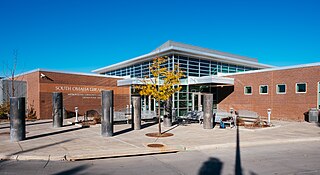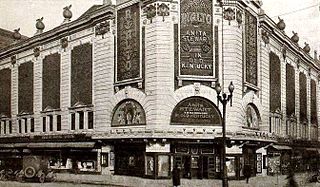
Broadway, until 1890 Fort Street, is a thoroughfare in Los Angeles County, California, United States. The portion of Broadway from 3rd to 9th streets, in the Historic Core of Downtown Los Angeles, was the city's main commercial street from the 1910s until World War II, and is the location of the Broadway Theater and Commercial District, the first and largest historic theater district listed on the National Register of Historic Places (NRHP). With twelve movie palaces located along a six-block stretch of Broadway, it is the only large concentration of movie palaces left in the United States.

Charles Howard Crane was an American architect who was primarily active in Detroit, Michigan. His designs include Detroit's Fox Theatre and Olympia Stadium, as well as LeVeque Tower in Columbus, Ohio, which remains that city's second tallest building.
Douglas Theatre Company was an American movie theater chain in based in Nebraska, operating in both Lincoln and Omaha. It was the 38th largest cinema chain in North America.

The Rose Blumkin Performing Arts Center or The Rose, also known as the Astro Theater, originally opened as The Riviera. It is located in downtown Omaha, Nebraska. Built in 1926 in a combination of both Moorish and Classical styles, the building was rehabilitated in 1986.

The Bradford–Pettis House is a historic house located at 400 South 39th Street in Midtown Omaha, Nebraska. It was designated an Omaha Landmark on February 26, 1980, and added to the National Register of Historic Places on July 21, 1983.

This is a list of the National Register of Historic Places listings in Douglas County, Nebraska.

The Paxton Hotel, formerly known as Paxton Manor and currently known as The Paxton, is located at 1403 Farnam Street in Downtown Omaha, Nebraska, United States. Designed by local architect Joseph G. McArthur, the current building was constructed in 1928, with its predecessor dating from 1882. Named for local businessman and community leader William A. Paxton, today the building houses luxury condominia. It is one of the few significant Art Deco structures in Omaha today. Among some of the prominent guests who stayed at the Paxton were Buffalo Bill Cody and William Jennings Bryan, as well as President William McKinley stayed at the Paxton during the Trans-Mississippi Exposition in 1898.

The Herndon House, later known as the International Hotel and then the Union Pacific Headquarters, was an early hotel located at Ninth and Farnam Streets in present-day Downtown Omaha, Nebraska. Built in 1858 by Omaha pioneer Dr. George L. Miller along with several associates, it was financed by the sale of city-donated land and a $16,000 loan. It was used as the headquarters building of the Union Pacific Railroad for more than 50 years; it was demolished in 1922.

The original Carnegie South Omaha Public Library, designed by Thomas R. Kimball, was built in 1904 at 23rd and M Streets in South Omaha, Nebraska. A Carnegie library, it was razed in December 1953; a new library constructed in the same spot opened in October 1954. The second library building was officially closed on May 17, 2008, when a new branch was opened at 2808 Q Street.
Mendelssohn, Fisher and Lawrie was a significant architecture firm in early Omaha, Nebraska. Fisher & Lawrie continued. A number of their works are listed on the National Register of Historic Places.

George W. Lininger (1834-1907), was an implement dealer, art collector, private gallery owner, and civic leader in Omaha, Nebraska, USA. Many of the art works Lininger collected became the foundation of the permanent collection at the Joslyn Art Museum in Omaha.
The 2014 Nebraska Danger season was the fourth season for the Nebraska Danger as a professional indoor football franchise and their fourth in the Indoor Football League (IFL). One of nine teams competing in the IFL for the 2014 season, the Nebraska Danger were members of the Intense Conference. For the fourth consecutive year, the team played their home games under head coach Mike Davis in the Eihusen Arena at the Heartland Events Center in Grand Island, Nebraska.
Rocheford & Gould were brick manufacturers and construction contractors in early Omaha, Nebraska. The firm built numerous brick structures during Omaha's transition from the wooden buildings of Nebraska's territorial days to more permanent structures. The buildings the firm built included breweries, schools, packing houses, business blocks, Vaudeville theaters, street car barns and power houses, and civic buildings. Many of the structures the firm built have been demolished but a few of their earliest structures still exist and are listed on the National Register of Historic Places.
The Omaha Athletic Club was a social club building located at 1714 Douglas Street in Downtown Omaha, Nebraska, United States. The idea of such a building in downtown Omaha originated in 1915 when a group of Omaha businessmen, including George Brandeis, met to discuss its establishment.

The Rialto Theater was a movie theater at 1424 Douglas Street in Downtown Omaha, Nebraska. The building was razed in 1986 and the site paved over for use as a parking lot. The property was later redeveloped as part of the construction of the Union Pacific Railroad's headquarters building.
Boyd's Theater and Opera House was a theater and opera house at 1621 Harney Street in Downtown Omaha, Nebraska. It was demolished in 1920 and the property redeveloped for the then owner's department store business.
The Moon Theater was a silent movie theater at 1410 Douglas Street in Downtown Omaha, Nebraska. The 1,600-seat theater was built on the site of Omaha's first movie theater, the Parlor. In later years the theater was renamed the Town Theater and eventually the Cooper Theater. The building was demolished in 1976.

The Portrait of Dirck van Os is a later painting by Rembrandt (1606–1669), created circa 1658. It is currently in the permanent collection of the Joslyn Art Museum in Omaha, Nebraska.
The 1922 Creighton Blue and White football team was an American football team that represented Creighton University as member of the North Central Conference (NCC) during the 1922 college football season. In its second season under head coach Howard M. Baldrige, the team compiled a 7–2–1 record and outscored opponents by a total of 111 to 80. The team played its home games in Omaha, Nebraska.











